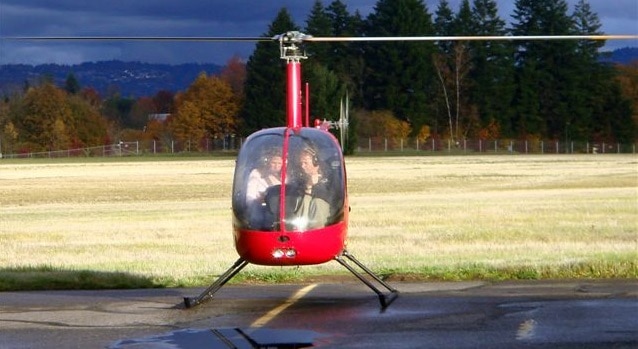
When it comes to learning to fly a helicopter there seem to be so many models to choose from. To the untrained eye, a helicopter is a helicopter but the differences between them can really make a difference to the quality of the training and also the bank balance.
The best training helicopters are the Robinson R22 & R44, Guimbal Cabri, and Schweizer 269C/300CB. All of these helicopters allow for fairly inexpensive rental costs, have a proven track record, and are fast, nimble, and predictable to allow for every maneuver to be learned fairly easily.
As a former flying instructor and having flown pretty much all of the helicopters mentioned I can give you a pretty good breakdown of which helicopter will be best suited to you.
Not every helicopter will suit every student and in this article, I’m going to show you why…
What is the Best Helicopter to Learn to Fly?
The four best and most common training helicopters are:
- Robinson R22
- Robinson R44
- Guimbal Cabri G2
- Schweizer 269/300 Series
Let’s take a look at each one of these and look at what makes them the best helicopter for you:
| Model | # of Seats | Avg Cost Per Hour | Availability | Engine Type | Avg Cruise Speed | Max Seat Weight |
|---|---|---|---|---|---|---|
| R22 | 2 | $345 Dual $280 Solo | ✓ | Carburetor | 80kts | 240lbs |
| R44 | 2+2 | $515 Dual $450 Solo | ✓ | Carburetor | 100kts | 300lbs |
| Cabri G2 | 2 | $350 Dual $270 Solo | X | Carburetor | 80kts | None |
| 269/300 | 2/3 | $345 Dual $280 Solo | X | Fuel Injection | 60kts | None |
Robinson R22
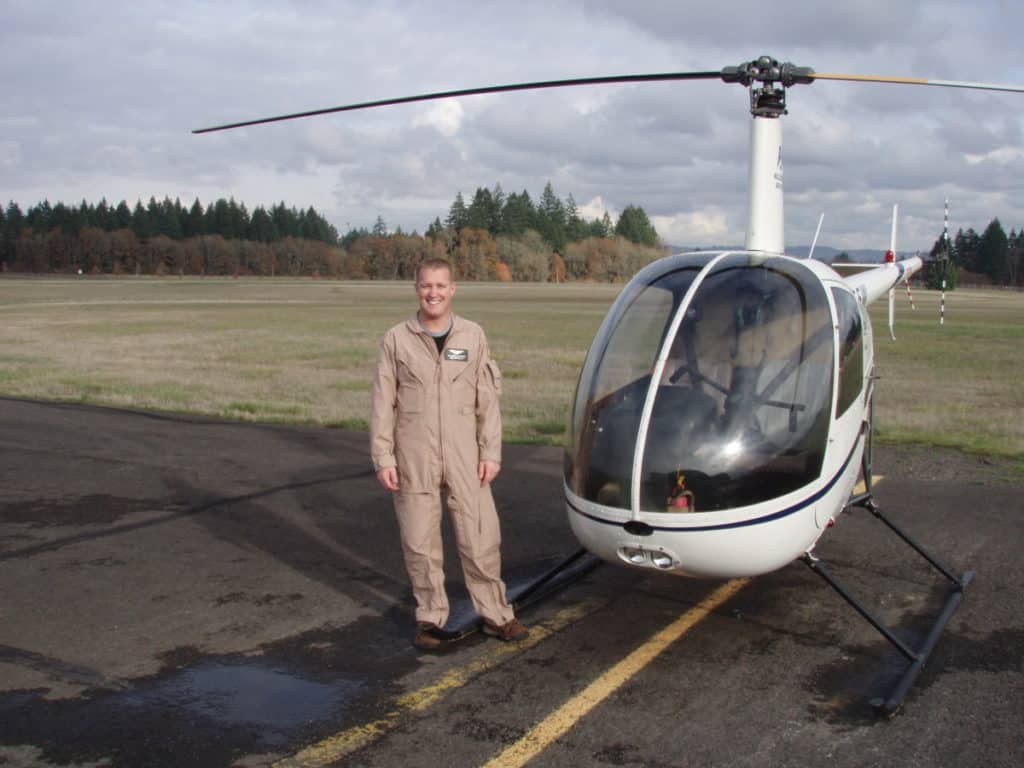
The Robinson R22 has been the ‘Go-To’ training helicopter for many flight schools across the globe for decades. Although, in recent years its larger brother the R44 and the Cabri have been nudging their way toward the top of the list for flight schools.
The R22 is one of the cheapest helicopters to learn to fly in, averaging around $345USD per hour with an instructor and fuel, and around $280USD when it is to be hired without the instructor for solo flights and hour building.
The R22 is a fast little helicopter making it perfect for the long cross-country training flights that are part of both the Private and Commerical pilot certificate syllabuses. With an average cruise speed of 80kts that can be wound up to 90 kts with a light crew, it soon chews through the miles allowing for a quicker flight and less cost.
There are several drawbacks to the R22:
- T-Bar Cyclic Control – Takes some getting used to
- Very Nimble – Tough for learning at first, but teaches great aircraft control
- Carburetted Piston Engine – Prone to Carburetor Ice (Wiki) if not monitored
- Low Intertia Rotorhead – Loses Rotor RPM quickly
- Max Seat Weight – 240lbs/108kg. Not good for heavier students
- Small Cockpit – Tall or wide students may find it uncomfortable
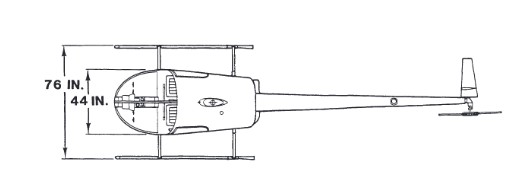
The R22 is a small helicopter! With a cabin width of only 44″ it gets really cozy in there for just regular-sized folk. If you are tall, have broad shoulders, wide hips/thighs, or are over the maximum seat weight limit of 240lbs/108kg then the R22 is not going to be the best option for you.
For the average student to complete an FAA Private Pilot Certificate in a Robinson R22 it will cost around:
FAA Minimum:
40 Total:
30 hours Dual x $345 = $10,350
10 hours Solo x $280 = $2,800
Flight Training Minimum Total = $13,150
Typical Student Average:
60 Total:
50 hours Dual x $345 = $17,250
10 hours Solo x $280 = $2,800
Flight Training Typical Total = $20,050
Like every helicopter, there had to be compromises made during the design stage but in all, there is a reason why this has been at the top of the list as a training helicopter for decades. It should not be hard to find a flight school operating these helicopters near you.
You may hear pilots talk about how they would never get in a Robinson helicopter and to be honest most of those that I have met have never flown one. Yes, they can have a reputation but trust me after 1000 hours of flying in an R22 I can tell which pilots trained in an R22 – They have much better hands and feet!
** Click Here for the Robinson R22 Flight Manual **
Learn More…
Try These Articles:
* Becoming a Helicopter Pilot: The Complete Cost Breakdown
* Do All Pilots Need Sunglasses? : Yes, Find Out Why!
Robinson R44
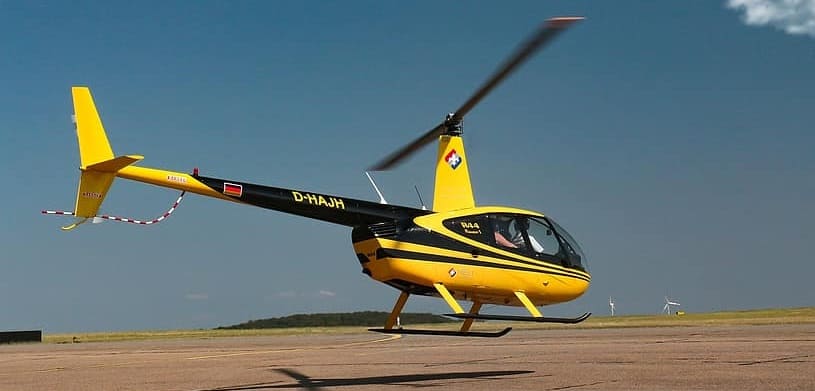
The Robinson R44 is the younger and larger brother built on the pedigree of the R22. This helicopter offers room for the pilot and 3 passengers with increased space within its cabin. Having a larger rotor diameter this helicopter is more stable compared to the R22, making it a little easier to learn on and the rotor system also has increased weight that helps to maintain RPM in autorotations, making them a little easier to master also.
The R44 still uses the Robinson T-Bar cyclic configuration and for those moving from an R22 to an R44 will instantly recognize the helicopter both inside and out as Robinson took the design mantra of ‘If it’s not broke, don’t fix it’ and basically duplicated most of the R22 and made it bigger for the R44.
This ‘Bigger’ also makes the helicopter available to many pilots that the R22 could not fit. The R44 has an increased individual seat weight limit of 300lbs, a 6.5″ wider, and a less claustrophobic-feeling cabin. Its higher 100 kts cruise speed allows for faster A to B flights which many pilots seek.
There are several drawbacks to the R44:
- T-Bar Cyclic Control – Take some getting used to
- Carburetted Piston Engine – Prone to Carburetor Ice if not monitored
- Larger Size – Requires two people to ground maneuver
- Max Seat Weight – 300lbs/136kg. Not good for heavier students
- Expensive – Almost 2/3 more of the hourly rental cost of the R22

The R44 is a great helicopter to train in however, due to its higher rental costs it’s not a helicopter I recommend students do ALL their training in. This helicopter is great to progress onto once the student has gained a pilot certificate, especially if they wish to fly for pleasure and to take several passengers out for lunch, away days and getaways etc.
All of the initial flight training should be completed in one of the smaller helicopters (provided you fit) as they allow you to gain the necessary muscle memory of physically learning how to control a helicopter but at a much lower price!
For the average student to complete an FAA Private Pilot Certificate in a Robinson R44 it will cost around:
FAA Minimum:
40 Total:
30 hours Dual x $515 = $15,450
10 hours Solo x $495 = $4,950
Flight Training Minimum Total = $20,400
Typical Student Average:
60 Total:
50 hours Dual x $515 = $25,750
10 hours Solo x $450 = $4,500
Flight Training Typical Total = $30,750
As you can see the cost of a typical Private Pilot Certificate completed on the R44 is $10,000 more compared to training on the R22. Many students will complete their training on the R22 and then take a 5 Hour Conversion Course for around $3000, saving $7000!
The Robinson R44 is one of the world’s most popular private helicopters and for good reason. It is a very solid helicopter with over 6,000 machines sold since its first flight in 1990.
** Click Here for the Robinson R44 Flight Manual **
Guimbal Cabri G2
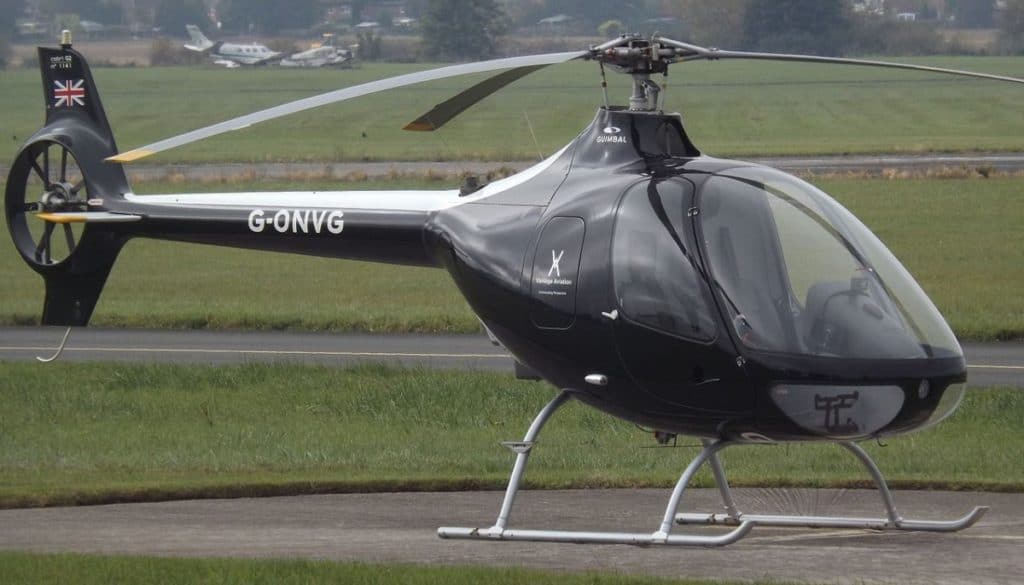
The Cabri G2 from Hélicoptères Guimbal is the new kid on the block. Designed by a former ‘Eurocopter’ engineer this helicopter has been refined over the last few decades into one of the fastest-growing training helicopters all over the world.
This small, modern, two-seat helicopter has a typical hourly rental cost of around $350/hour with an instructor and $270/ hour for solo hire. This helicopter features a modern glass cockpit, three-bladed fully articulated rotorhead, and Fenestron tail rotor system that you can easily see have been mirrored off the many incredible Eurocopter helicopters.
This state-of-the-art helicopter features composite rotor blades and structure, a crash-resistant fuel cell, and energy-absorbing crash-resistant seats. Many of the issues leading to accidents at flight schools have been addressed in the design of this helicopter and its surge in popularity shows the designers got it right.
There are several drawbacks to the G2:
- Availability – Can be hard to find a local school operating them
- Carburetted Piston Engine – Prone to Carburetor Ice if not monitored

As you can see there are not that many cons to these great little helicopters. The shrouded tail rotor makes them great for ‘Off-Airport’ landings. The traditional style flight controls and ergonomic cockpit make them feel more like a helicopter.
Their stable handling and high-inertia rotorhead give the pilot/s much more buffer room when learning and their high cruise and large fuel capacity allow for fast cross-country training flights and great handling around the airport.
One of the other great features of the Cabri is that it has no listed limitation on the maximum seat weight. Providing the pilot keeps the helicopter within its weight and balance limitations they can fly the aircraft. It is still only a small cabin at only 48″ wide but has a regular-style helicopter cyclic control that helps taller and wider pilots fit in the aircraft.
For the average student to complete an FAA Private Pilot Certificate in a Cabri G2 it will cost around:
FAA Minimum:
40 Total:
30 hours Dual x $350 = $10,500
10 hours Solo x $270 = $2,700
Flight Training Minimum Total = $13,200
Typical Student Average:
60 Total:
50 hours Dual x $350 = $17,500
10 hours Solo x $270 = $2,700
Flight Training Typical Total = $20,200
Coming in at roughly the same hourly cost as a Robinson R22 these great little helicopters are becoming the training helicopter of choice for most students who can get their hands on one. However, finding that flight school might take a little more searching!
** Click Here for the Guimbal Cabri G2 Flight Manual **
Learn More…
Try These Articles:
* Pilot Medical Exam – What You Need To Pass Each Class
* Can You Become a Pilot If You Are Color Blind? It Depends!
Schweizer 269/300
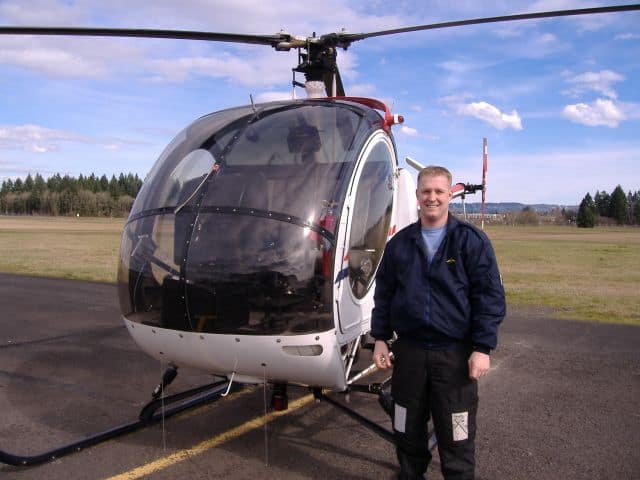
The original training helicopter was designed to compete against the infamous Bell 47 (M*A*S*H) helicopter. This helicopter has been seen in training schools all over the world since the early 1960s and it has a great safety pedigree behind its many iterations.
The original 269C was a two-seat, carburated piston engine, but today’s latest model the 300CBi features a fuel-injected 180hp engine which eliminates the issue of Carb Ice and the option for the cabin to contain two or three seats.
When configured for two seats this is the helicopter to fly if you are taller, wider, or heavier to comfortably fit in any of the other training helicopters mentioned. Just like the Cabri, this helicopter has no maximum seat weight limitation, it just has to be kept within weight and balance limitations.
The tall and wide cabin easily accommodates every student and it even has adjustable pedals for those that are vertically challenged like myself (I’m 5’6″/168cm).
With a comparable hourly operating cost of the other 2 seat helicopters, this is a great helicopter to learn to fly on. With an instructor, this helicopter averages around $360/hour and $300/hour for solo rental.
There are several drawbacks to the 269/300:
- Availability – Can be hard to find a local school operating them
- Carburetted Piston Engine – Prone to Carburetor Ice if in the 269C/300C & 300CB models
- Steep Glide Ratio – Doesn’t glide far in autorotations
- Ground Resonance – Prone to Ground Resonance during hard touchdowns
- Slow Cruise Speed – Makes for a long duration of A to B flights
- Brutal In Headwinds – Large, flat canopy window really slows groundspeed in a headwind
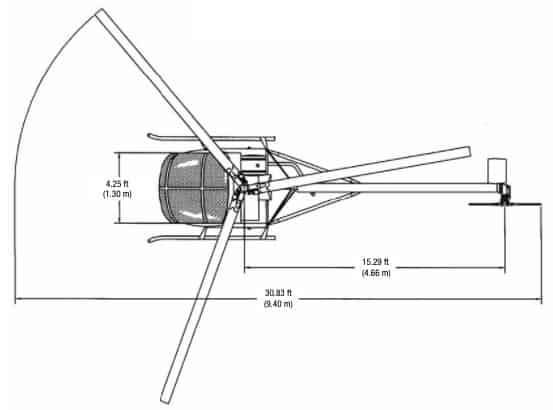
The larger cabin of this helicopter is great for people of any size and this increased space adds stability to the aircraft, coupled with the 3 bladed, fully articulated rotor system. This helicopter will feel more sluggish compared to the R22 but flies with smooth, predictable characteristics.
This is a great helicopter for training around the airport but one of its major flaws is its speed. Even a small headwind can really hamper the progression of this helicopter getting anywhere due to its very large, flat, canopy windscreen.
A great little helicopter that allows impressive views from its cabin, has a simple-to-inspect airframe, and is fun to fly, just don’t plan to fly long distances with a good headwind!
For the average student to complete an FAA Private Pilot Certificate in a Schweizer 269/300 it will cost around:
FAA Minimum:
40 Total:
30 hours Dual x $345 = $10,350
10 hours Solo x $280 = $2,800
Flight Training Minimum Total = $13,150
Typical Student Average:
60 Total:
50 hours Dual x $345 = $17,250
10 hours Solo x $280 = $2,800
Flight Training Typical Total = $20,050
Having a comparable hourly rental rate to both the R22 and the Cabri this helicopter makes it easy for anyone to fly. With no seat weight restrictions and an ample cabin, this is the helicopter of choice for those finding the cockpits of the other helicopters a little too tight.
** Click Here for the Schweizer 269C/S300C Flight Manual **

Join My Newsletter & Get Great Tips, Information and Experiences To Help You Become a Superb Pilot!
Can I learn to Fly in a Turbine Helicopter?
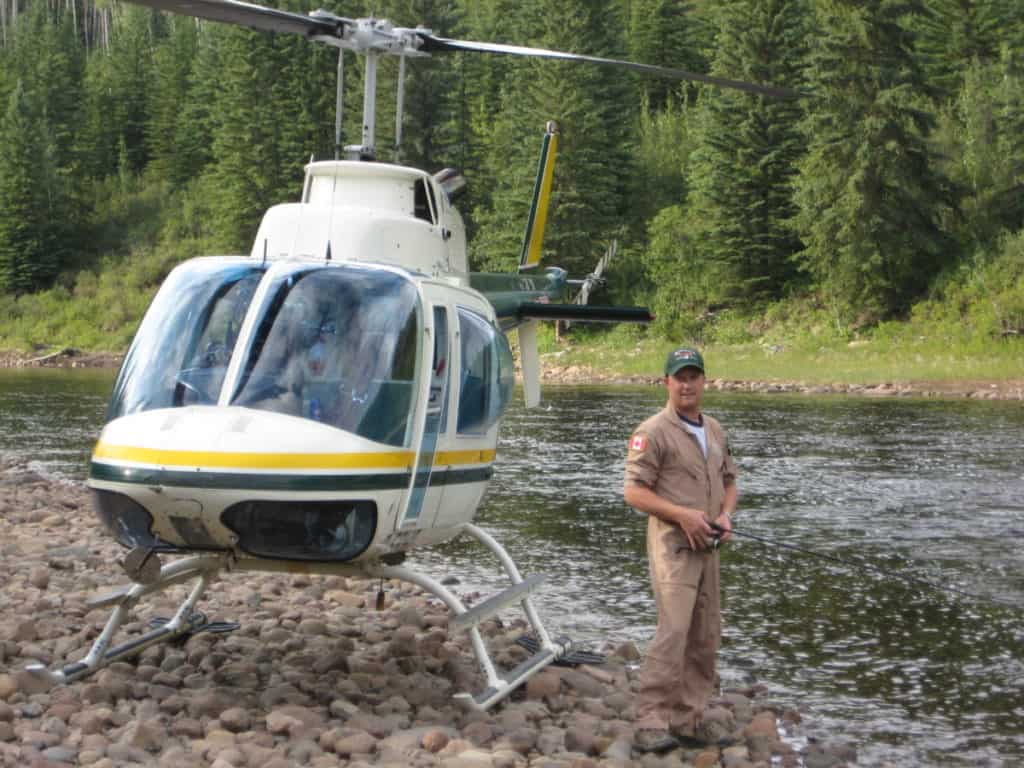
Training is regularly completed in turbine helicopters, especially for annual recurrent pilot training of professional pilots. Helicopters like the Bell Jet Ranger, Airbus H125, and Robinson R66 are all very common training helicopters. They are a lot more expensive to rent than piston-powered helicopters.
Turbine helicopters are not cheap to run or rent! Because of this, the cost of completing an entire Private Pilot or Commercial Pilot certificate is considerable. The only people who I have seen do their entire training in a turbine-powered helicopter are those in the military or private owner who is being trained in their own helicopter.
For someone wanting to learn to fly, a turbine helicopter can be used without any issues at all, in fact, you will find many flight schools will have a Bell 206 Jet Ranger or similar-sized helicopter available. The training syllabus in a turbine helicopter is exactly the same as it is in a piston-powered helicopter, the only difference is the price.
For the average student to complete an FAA Private Pilot Certificate in a Bell 206 Jet Ranger it will cost around:
FAA Minimum:
40 Total:
30 hours Dual x $1,200 = $36,000
10 hours Solo x $1,135 = $11,350
Flight Training Minimum Total = $47,350
Typical Student Average:
60 Total:
50 hours Dual x $1,200 = $60,000
10 hours Solo x $1,135 = $11,350
Flight Training Typical Total = $71,350
The cost to complete a typical Private Pilot Certificate on a turbine helicopter is roughly the same price as doing an entire professional pilot program in a two-seat, piston-powered helicopter.
Just like the R44, most students will complete their training on a smaller piston-powered helicopter and then spend around 3-5 hours doing a ‘Turbine Transition’ course where they learn all about the turbine helicopter, how it differs from a piston-powered helicopter, and practice the emergency procedures.
Can I Learn to Fly in my Own Helicopter?
Owners of private helicopters can employ a flight instructor to give them training in their own helicopter. The hourly rental rates are far lower than a flight school, but the owner bears all the risk if a mishap occurs. Insurance rates will be considerably higher when flown for training.
Over my years of flying and training, I have seen this a handful of times. A wealthy individual has purchased their own helicopter and wants to be taught how to fly it. This way they get to learn how their aircraft feels and flies. They get to familiarize themselves with its size when fitting into tight, confined landing areas and the main benefit is the cost.
When a person rents a helicopter, the flight school has to have a healthy margin added to the hourly rate to cover the cost of hull depreciation, maintenance, fuel, insurance, facilities, employees, and profit. For those individuals who have their own helicopter, the hourly rate is far less.
Take the Robinson R44 for example. It is one of the most popular private helicopters:
Flight School Hourly Cost with No Instructor = $495
Private Owner Hourly Cost with No Instructor = $260
The cost to train is almost half that of renting from a flight school, but the owner bears ALL the responsibility. Hard landings, stinger strikes, engine over speeds, and main rotor over speeds are all common in training. They are never planned, but they happen.
The cost savings of using your own helicopter can soon be consumed by having to have your aircraft inspected and/or parts replaced because you or your instructor ‘Screwed up’, because of this, insurance rates are increased dramatically while the helicopter is being used for training.
My advice would be to learn in the same helicopter but use the flight school machine. This way they bear all the risk and you get to keep your nice, shiny new helicopter looking like new and not beaten like a training helicopter can become!
Learn More…
Try These Articles:
* Buying a Helicopter? Which is the Best?
* Can Anyone Build a Helicopter? Top 5 Kits
Can I Learn to Fly in a Kit Helicopter?
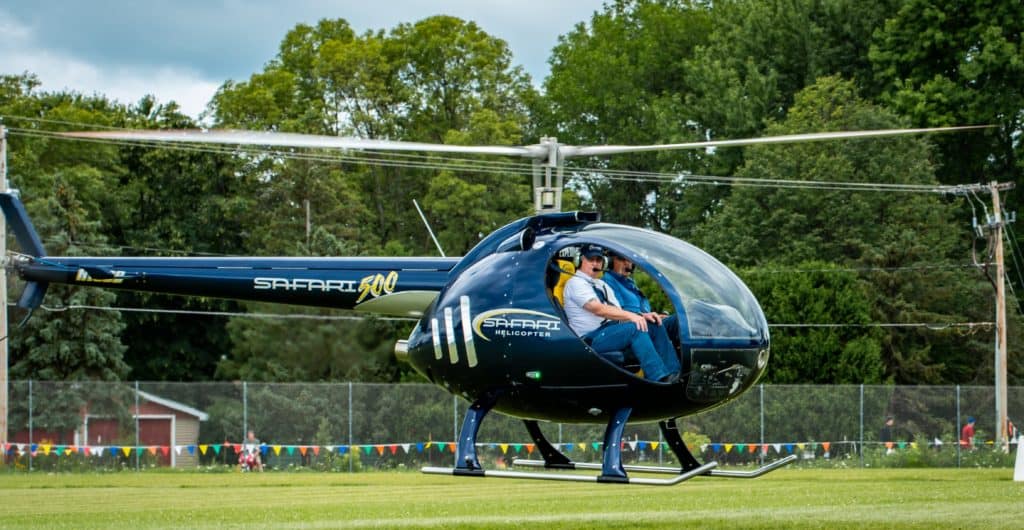
Most kit helicopters are only single-seat which makes learning to fly in them incredibly dangerous. There are two-seat kits which are a very popular option for the builders. An instructor familiar with the kit can then teach the student but finding that instructor can be very difficult.
There are around 5-6 popular helicopter kits and those who wish to build their own will need to learn how to fly. The main reason many people purchase a kit helicopter is to save money and the cheapest kits are only a single seater. This makes learning in them very difficult.
To be able to learn to fly in a kit the pilot needs to either purchase or learn in a two-seat kit helicopter or learn in one of the mainstream helicopters mentioned above, then transition to their kit.
There are communities of kit helicopter owners all over the globe and finding an instructor that is familiar with the type of kit purchase is best done through that network. Having an instructor that knows that helicopter and how it flies and handles is paramount to ensure the highest level of safety while being taught.
Most instructors can be hired for between $50-$100 per flight hour.

